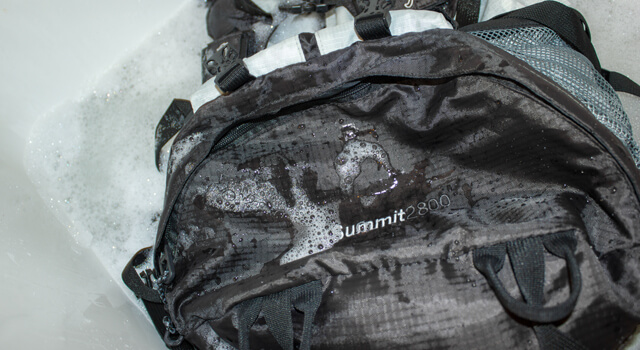A backpack is something most people will use at one point or another in their life. The adventurous traveler, the student, the digital worker; everyone who wants to carry their belongings in a safe and convenient manner will find a backpack useful.
And like most of your belongings that are used regularly, it gets dirty. You’ve put that old backpack to quite a bit of use, and you’re wondering if you can wash it?
The answer is a definite yes, unless the manufacturer tells you not to. But that’s an entirely different case. Be it a school backpack or a hiking backpack, no matter how much you take care of it, eventually dirt and grime will get onto it, degrading the fabric.
Why backpacks need to be washed
Your backpack may have been stained with your body sweat and oils just from daily use. If it’s a children’s backpack, the usual culprit will be food stains, spilled juice, gum or candy. And if it’s an outdoor backpack, smoke from camping, mud, even animal pee can find its way to your backpack.
All that sand and dirt you subject your backpack to is sure to get in the pockets and zippers which can make them get stuck. Don’t forget dirty clothes and socks, which can cause diseases if you don’t disinfect and clean the bag thoroughly. And that’s not to mention the bad smell.
In order to prolong its life, you should regularly clean your backpack. And there are a few ways to do it:
Here’s how to wash a backpack so it looks brand new again

First and foremost, you should determine if your backpack is indeed washable. As a general rule, most backpacks that are made with nylon or canvas are safe to wash. If you have a backpack with a material that you are unsure about getting wet, check the care label to see the exact instructions for cleaning your backpack.
If you can’t find a label or any instructions, start with just a small area and see if the material can handle a bit of soap and water before you commit to a more thorough wash. Basically, like most fabrics, you can wash your backpack by hand or with a washing machine. Let’s explore a few ideas to get you started.
Pre-wash tips
Before you get that backpack wet, there are a couple of things you need to do. Ideally, waterproof backpacks should not be washed often as this can affect the waterproofing effects. But this can be remedied by using waterproofing sprays to replace the coating.
- Turn the backpack inside out and give it a good shake to get all of that loose dirt, sand or small debris out of the bag. You might be surprised at what you uncover.
- Most backpacks will have metal parts or frames. Take these out before you wash it. You should also detach any removable pockets or accessories as they might come off during washing and damage the washing machine if you’re using one.
- Use a small vacuum to gather all the dust, sand or food crumbs.
- If you’re just handwashing your backpack then loose threads might not be an issue, but if you’re using a washing machine you need to cut these off or they might get snagged when being machine washed and further rip the material.
- Even zippers can be dirty and get stuck, so clean them with an old toothbrush.
How to hand wash a backpack with just a sponge and soap

If your backpack is not that dirty, then you might only need to do a few basic things. All you need is some gentle soap like Castile, a sponge or a nylon brush. For the interior, you don’t need to get it wet, so a dry sponge will do the trick. For the outer part of the backpack, use a little bit of water, a sponge and soap.
If there are stains on the bag, use a dry-cleaning solvent to remove them. A light clean may not be enough if your backpack has been in use for a long while. If a sponge won’t do the trick, then you might need to use a more deep cleaning method.
Washing a backpack using a basin, tub or large sink
Depending on the size of the bag, you can use your kitchen or bathroom sink to submerge your backpack. Use lukewarm water and gentle soap with a sponge to scrub off stubborn spots on the outside and the interior of the backpack. Take care not to scrub too hard on materials that could tear or break easily.
To rinse off all that soap, fill the basin or tub a second time with clean, cold water. Submerge the backpack and rinse it as thoroughly as possible. If you don’t want to wait for the water to fill, a high-pressure cold shower will do the trick as well.
Can you put a backpack in the washer?
If you have a backpack that is made from materials that shouldn’t come into contact with water, like leather, then it’s definitely a no. But most standard backpacks are machine washable as long as you take the pre-wash steps above.
How to wash a backpack in a washing machine

After checking the backpack for any loose material and doing the pre-wash steps, you’re ready to use your washer for your backpack. Use only the delicate or gentle setting and do not let it tumble dry. This is especially important if your backpack is waterproof and you do not want to damage the coating.
You don’t need anything fancy, just a gentle detergent and cold water. If you feel that your backpack needs to be disinfected, use pine oil along with the detergent. Put the backpack in a large mesh bag or old pillowcase so nothing gets scratched and both the washing machine and backpack are protected.
Can you put a backpack in the dryer?
Most people would advise against it as you could damage the padding. It is a better idea to let it air dry for a few days. To ensure that no water remains in the pockets or compartments, hang it upside down.
What to do after your backpack is cleaned and dry
Sometimes, there is a lingering odor from your backpack that won’t go away even after it’s been thoroughly cleaned. A good odor eliminator will do the trick to get rid of that urine or other unpleasant smells.
You might also need to re-waterproof your backpack’s surface if you feel the wash could have stripped some of the waterproof capabilities. Before using the canvas waterproofing spray, place a towel inside the backpack to absorb any moisture that seeps through. Make sure the backpack is sealed properly before spraying and that each surface of the backpack, including pockets and seams, are coated.

